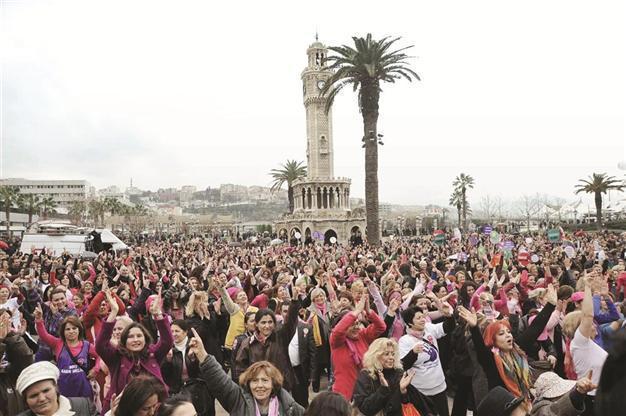Patriarchal mindset remains, women still seen below men
Marmara Group Foundation Social Projects Coordinator Müjgan SUVER

People are seen dancing during a global protest day against violence against women in the Aegean province of İzmir in this file photo. DHA photo
One of the main panels of the 16th Eurasian Economic Summit is “Modernization and Women.”
The Daily News recently talked to Müjgan Suver, the president of the Marmara Group Foundation’s EU and Human Rights Platform, on the matter.
If we compare the economic, social and cultural status of women in Eurasian countries with that of women in Turkey, what do we see?The socio-economic status of the women in Eurasian countries is closely related with the modernization of those countries.
In addition, in the countries in which the patriarchal mindset remains unchanged, even if modernization is completed, women are seen as being below men and evaluated based on their status in their family.
In other words, in Eurasian countries, women’s status within society runs parallel with a given country’s level of technology, industrialization, democracy and urbanization.
In Scandinavian countries like Sweden, Norway, Belgium and Finland, the rates of women’s participation in the workforce, politics and education reaches ideal numbers (60-70 percent). In the countries that are located in Central Europe, like Germany and the Netherlands, women are participating in political life at around 33 percent, but participate in economic life at roughly 60-70 percent.
Although the numbers related to male-female equality in Italy, Greece, France and the Balkan countries are up to 40-50 percent in working life, in terms of political participation, it remains around 20 percent. In the Caucasus, Russia and the Central Asian republics, the number of women in economic life is decreasing rapidly, and political participation remains around 12-15 percent.
Bad recordIf we are to compare Turkey with these countries, according to the United Nations Development Program (UNDP) Humanitarian Progress Report, from the perspective of male-female equality, Turkey’s status is not very impressive.
Turkey ranks second worst after Mexico among the OECD countries. The proportion of women in political life is 15 percent, and the proportion of women in economic life – despite all the encouragement of recent years – is below 30 percent.
When we see the numbers of the developed countries, we also see that there can be no development without women. We see in TEPAV’s research that unless women are drawn into economic life, even if 100 percent of men are employed, we cannot reach $25,000 per capita income by the centenary of the Turkish Republic. We need to raise the female employment rate up to 72 percent if we are to reach $25,000 per capita income by 2023. Unfortunately, the 38 percent female employment rate that the government is aiming for by 2023 cannot bring us to this goal.
We need to swiftly solve our industrialization, urbanization and democratization problems and determine our road map in accordance with our goals.
What aspects of female employment will be addressed in the 16th Eurasian Economic Summit?In the Women’s Session of the 16th Eurasian Economic Summit, we will discuss the struggles of industrialization, urbanization and democratization – the foundations necessary for women to take an equal place with men in every part of society – and their impact on women.
We cannot have a strong democracy without solving our industrial and urbanization problems. Equality, equal opportunity and equal rights cannot be administered in the absence of a strong democracy.
When we look at Turkey’s future, we see two problems distinct from those of the Western world. The first is an incomplete and late modernization. The second is the problems within modernization itself. Turkey is experiencing both of these problems together, and has to solve both of these problems together as well.
